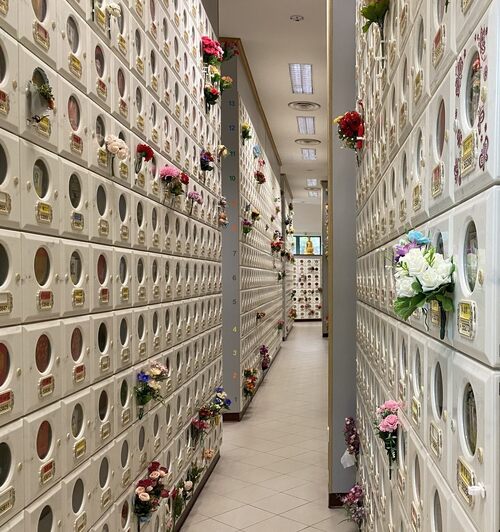

In This Story
On a warm December day in one of the last cemeteries in Singapore, Man Zu begins to chant. His orange Taoist robes stand out amidst the thousands of gray gravestones; his round face is tan and leathered from years of working in the sun. He is here today to help a group of siblings exhume and relocate the remains of their father, mother, and uncle.
Choa Chu Kang Cemetery does not look like the busy metropolis that is Singapore. There is barely a building in sight; the tallest structure stands about 1,000 feet away, a single-story building equipped with a food stall. In the vicinity, there is a branch of the National Environment Agency, situated near the cemetery to help families exhume their ancestral graves.
Much of the cemetery looks dilapidated, dotted with heaps of rubble and clumps of weeds. The air smells of mud, sand, and grass. Destroyed tombstones stand next to others that are still intact, scattered with miscellaneous debris: incense holders, empty Oreo packets, broken vase fragments. Stray dogs, a rare sight in urban Singapore, patrol the area.
The mass obliteration of graves—or, as it is more commonly known, exhumation—is a result of the government’s redevelopment plans. The Choa Chu Kang Cemetery Exhumation Programme was announced in 2017 to make space for the expansion of an airbase, which necessitates the relocation of more than 80,000 graves. The Cemetery is home to Chinese, Muslim, and Hindu graves. In the current phase, more than 45,500 Chinese graves will be exhumed.

Man Zu conducts Taoist rites to prepare remains for exhumation. YIN LIN TAN
The eco-friendly approach reflects Taiwan's shifting funerary practices.
Choa Chu Kang Cemetery’s fate is a mirror of what happened to Bukit Brown Cemetery in 2013. At the time, Singaporeans protested its destruction. Bukit Brown was the resting place of key historical figures and home to a quarter of the bird species in Singapore, but it was was demolished to make space for a new highway.
As recently as 1978, there were 213 cemeteries in Singapore, with burial grounds both large and small scattered across the island. (At approximately 278 square miles, the entire country is smaller than New York City.) By 2011, there were only 60 cemeteries. Many estates and malls stand on former cemeteries, from Singapore’s most popular shopping district, Orchard Road, to residential neighborhoods in the heart of the city-state.
Though most cemeteries have been demolished, the few that remain serve as reminders of the many communities that have called Singapore home. The Japanese Cemetery Park, established in 1891, offers a glimpse into the world of early Japanese settlers: soldiers, merchants, young women brought to Singapore as sex workers. Cemeteries also showcase Singapore’s religious and cultural diversity, with designated sites for Christians, Hindus, Muslims, Jews, and the different Chinese clans.
